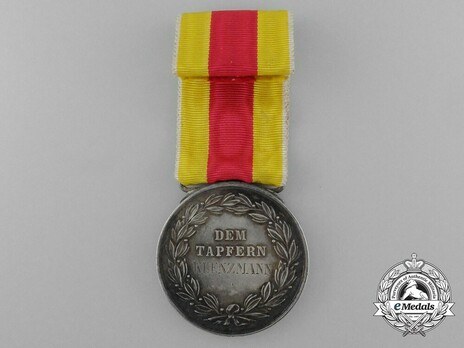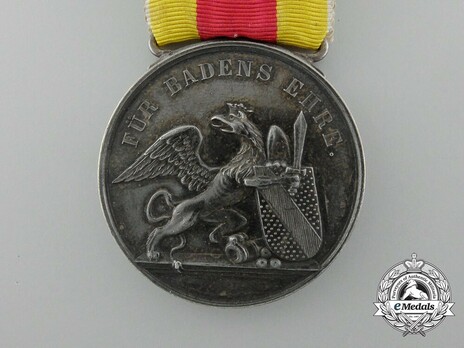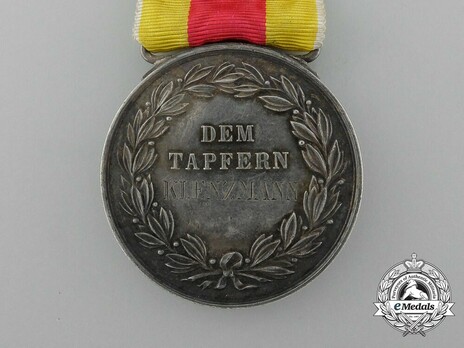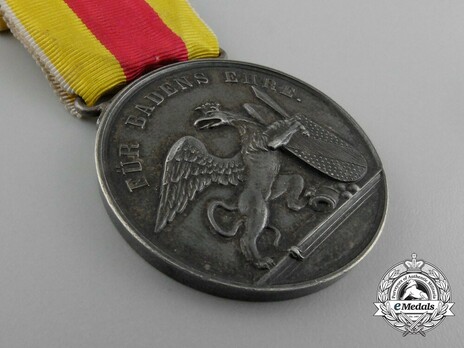Order of Military Merit of Charles Frederick, Silver Medal (1915-1918)
CATEGORY: Version
SKU: 01.BAD.0102.202.01.007
Estimated market value:





Estimated market value:
34 grams
The Order of Military Merit of Charles Frederick was instituted by Grand Duke Charles Frederick on April 4, 1807. The Grand Duke had previously spoken of the order, but could not institute any statutes as the army of Baden had not initiated a battle with an enemy until 1807. It was originally restricted to officers in recognition of distinguished military merit or an outstanding act of courage.
It originally featured three grades: Grand Cross (with Breast Star), Commander and Knight. In 1807, the Military Merit Medals were added to the Order with gold and silver grades, and the medals could be awarded to Non-Commissioned Officers and Enlisted Men. The medals were engraved with the name of the recipient. The Military Merit Medals were the highest military decoration awarded for bravery that could be conferred upon Non-Commissioned Officers and Enlisted Men.
The first award ceremony of the Order of Military Merit of Charles Frederick took place on April 22, 1807 in the Danzig camp.
The Commander grade was divided into two separate grades in 1840, I Class Commander and II Class Commander.
The crosses of the Order were originally composed of gold, but following 1916, the crosses were predominantly composed of silver gilt.
The order cross and medals were accompanied by an allowance. The general treasury allotted 2,200 guilders to pay the allowances. The two oldest Grand Cross recipients received 400 guilders, the three oldest Commander Cross recipients received 200 guilders and the eight oldest Knights received 100 guilders annually. From 1820, the pension of the Grand Crosses ceased to exist. Instead, the eight oldest Commander Cross recipients received 200 guilders and the 24 oldest Knights received 100 guilders annually.
Grand Duke Charles Frederick took over the dignity of Grand Master. All male members of the ducal house were born holders of the order, but without the pension. This did not last, and by 1870 was terminated.
The number of recipients of the order was not limited and individuals of every military branch, regardless of religion, rank, birth or other circumstances could receive the award. Generals could only receive the Grand Cross and Commanders only received the Grand Cross Breast Star when they advanced to the position of general. An exception to that statute was 25 years of loyal service and the recommendation of the highest person of a sovereign. However, that provision was withdrawn in 1831.
The members of the order could add the insignia to their coat of arms. Upon the recipient’s death, the award had to be returned. If a recipient retired from active service they were permitted to wear the award with civilian clothes.
In 1814, holders of the French Legion of Honour had to exchange them for the Order of Military Merit of Charles Frederick, but that provision was reversed in 1818 and both awards could be worn next to each other.
The Military Order of Merit of Charles Frederick was abolished on November 8, 1918. The campaigns in Spain (1808), Austria (1809), Russia (1812), Silesia and Saxony (1813), and France (1814-15) caused a rise in the number of medal recipients.
Until the Military Service Award was instituted in 1831, the Military Merit Medals were awarded to recognize 25 and 40 years of service. The reverse of the Military Merit Medals featured the inscribed name of the recipient. The name was inscribed in cursive letters until 1870, and after 1870 the names of the recipients were inscribed in block letters. In 1849, the reverse of the Silver Military Merit Medals featured the rank of the recipient.

Comments
Sign in to comment and reply.


Scroll Top